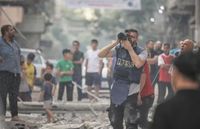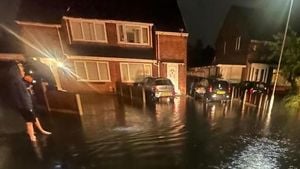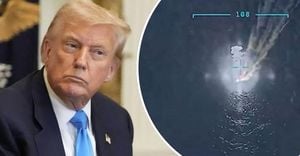On August 15, 2025, the Canadian Association of Journalists (CAJ) issued a sharply worded statement condemning what it described as the targeted killing of journalists in Gaza. The CAJ’s declaration, which accused Israel of deliberately targeting members of the press, set off a wave of debate across the media landscape, highlighting the complex and deeply contentious nature of reporting from one of the world’s most dangerous conflict zones.
Just a month later, on September 15, United Nations special rapporteur Irene Khan added her voice to the chorus of concern, accusing Israel of intentionally targeting journalists in Gaza as part of what she called a “cover-up of genocide.” Speaking to reporters in Geneva, Khan declared, “The way in which journalists are being killed, silenced ... is the cover-up of genocide.” She cited the latest United Nations figures, which indicate that at least 252 Palestinian journalists have been killed in Gaza since the war erupted following Hamas’s unprecedented attack on Israel on October 7, 2023. “More journalists have been killed in Gaza than in both World Wars, Vietnam War, wars in Yugoslavia and the war in Afghanistan combined,” Khan said, underscoring the deadly toll this conflict has exacted on those trying to document it.
The CAJ’s statement, while expressing sorrow for the loss of life, was criticized by some commentators for its perceived one-sidedness. According to the CAJ, “journalists are dying, therefore Israel must be targeting them.” Critics argue that this logic, while emotionally compelling, fails to grapple with the broader context of the conflict—specifically, Hamas’s strategy of embedding itself within Gaza’s civilian infrastructure, from hospitals and schools to newsrooms, and using its own population as human shields.
One of the most contentious issues raised in the CAJ statement involves the deaths of specific journalists. Hossam Shabat, a correspondent for Al Jazeera Mubasher, was killed in an Israeli strike. The Israel Defense Forces (IDF) alleged that Shabat was not simply a journalist but also served as a sniper in Hamas’ Beit Hanoun Battalion. Al Jazeera and numerous press freedom groups denied these claims, insisting that Shabat was targeted for his reporting. Similarly, Anas al-Sharif, another prominent Al Jazeera figure, was killed in an Israeli strike on August 11, 2025. Israel again alleged connections to a Hamas cell, citing intelligence materials. Al Jazeera denied these allegations as well, and the deaths of both men quickly became rallying points for advocates of press freedom worldwide.
Yet, as some critics have pointed out, the distinction between journalist and combatant in Gaza is often blurred. There have been documented examples of individuals wearing “Press” vests while publicly praising Hamas, glorifying the October 7 massacre, or appearing alongside Hamas officials. According to the article published in response to the CAJ statement, “The idea that every Gazan with a ‘Press’ vest is a neutral observer is laughable.” The piece argues that by failing to distinguish between legitimate journalists and those acting as operatives or propagandists for Hamas, organizations like the CAJ risk undermining the credibility of the press itself.
This blurring of lines, critics warn, is not merely a matter of semantics. If Hamas fighters believe that donning a press vest and carrying a camera is enough to guarantee sympathetic coverage or even protection from attack, what incentive do they have to stop exploiting that cover? The tragedy, according to these voices, is that Hamas’s embedding of military assets within civilian—and journalistic—spaces makes Gaza perilous for everyone: civilians, aid workers, and reporters alike. The battlefield, they argue, has been deliberately designed to maximize civilian casualties, each one leveraged as a propaganda tool in the wider information war.
Despite these concerns, the CAJ’s statement focused its outrage squarely on Israel, presenting a narrative in which “brave journalists [are] targeted simply for doing their jobs.” The statement did not acknowledge Israeli allegations that some of the deceased were open members of Hamas or engaged in activities beyond reporting. Nor did it address the broader strategy of Hamas in embedding itself within civilian life. This, according to critics, results in a narrative that “comforts activists, flatters terrorists, and leaves the public misinformed.”
For her part, Irene Khan, the UN’s special rapporteur on the right to freedom of opinion and expression, rejected the idea that the majority of journalists killed in Gaza were anything but legitimate media workers. “They are being deliberately picked out and killed because of the work that they are doing to expose the atrocities, the crimes, the genocide on the ground,” she said. Khan also condemned what she described as Israeli “smear campaigns,” which accuse many of the journalists killed in its strikes of being “terrorist supporters or terrorists themselves” in an effort to “delegitimize and discredit” them and their work. “So it is not just killing journalists, but (an) attempt is being very clearly made here to kill the story,” she charged.
Khan also drew attention to Israel’s policy of blocking access to Gaza for international journalists. “What is happening in Gaza is extremely unusual,” she said. “I cannot recall another situation where a member state of the United Nations has denied access to independent international media for a conflict.” She warned that this sets a “terrible precedent” for media freedom and called for urgent international action: “States must stop Israel before all journalists in Gaza are silenced.”
The debate over the deaths of journalists in Gaza is emblematic of the broader struggle over narrative and truth in wartime. On one side, organizations like the CAJ and UN experts like Khan argue that the sheer scale of journalist fatalities points to a deliberate campaign to silence reporting and cover up atrocities. On the other, critics insist that the reality is more complicated—that Hamas’s exploitation of press protections and embedding within civilian infrastructure creates a fog of war in which the line between journalist and combatant is sometimes impossible to draw.
What’s clear is that the cost of this conflict for media workers is unprecedented. With at least 252 Palestinian journalists reported killed since October 2023, Gaza has become, in Khan’s words, “the deadliest conflict ever for journalists.” The stakes for press freedom, accountability, and the very nature of truth-telling in war have rarely been higher.
As the world watches, the deaths of journalists in Gaza continue to spark fierce debate—not just over who is to blame, but over how we define journalism, propaganda, and the responsibilities of those who bear witness in times of war.





